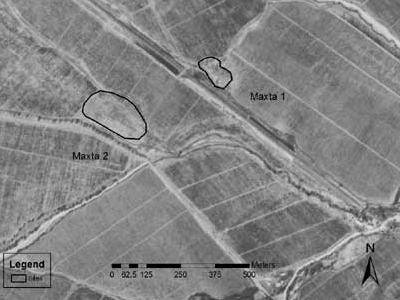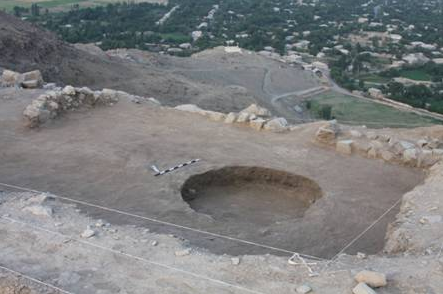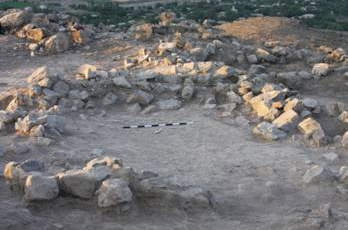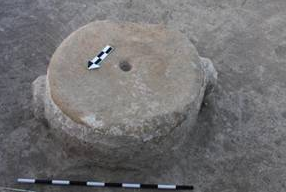Our second goal during the 2011 season was the excavation of the northern fortification wall at Oğlanqala. Radiocarbon dates from the northwest circular tower, and one of the square buttresses of the northern wall in 2010 indicated that this structure was probably built around 800 BC. Oğlanqala 5 pottery was found here as well, but it seems to have been deposited before the wall was built. This means that the fortifications at Oğlanqala were built around the same time that Urartu (ca. 850-600 BC), an empire centered in Turkey’s Van region, was launching military campaigns in the Caucasus and Northwest Iran.1 We were interested in finding out more about the fortifications. Had Oğlanqala’s fortification engineers built the wall according to Early Iron Age models? Or had they adopted Urartian techniques or construction models from their powerful neighbor? Urartian fortifications tend to be extremely standardized; they are characterized by regular buttressing, ashlar masonry and standard-sized mudbricks. 2 It seems likely that Urartian architects designed fortifications across the empire for the purposes of the state to assure this regularity.
Excavations at Oğlanqala’s Northern Fortifications exposed this feature over 215 m (Figure 4). Our work showed that the fortifications generally resembled earlier Iron Age architecture, but may have also imitated certain Urartian features. Unlike Urartian walls, which are generally straight and right-angled and have no respect for topography, Oğlanqala’s fortification wall conformed to the natural topography of Karatəpe. The Northern Fortifications exhibited a pattern of elaborate, but irregular buttressing. Two of the buttresses on the western side of this wall are quite regular, 7 m long, and 4 m wide, they are separated by a stretch of wall 15 m wide. Further to the east, however, this pattern breaks down. Instead of buttressing, the wall zigzags, with no regular pattern. Although buttressing is usually an Urartian feature, it does have antecedents in the architectural tradition of the South Caucasus, so it is not clear where the inspiration for this feature originated. This striking, angular wall, clearly visible from the nearby fortress of Qızqala would have been the first view of Oğlanqala for visitors coming from the north. There is no exact counterpart to the shape of Oğlanqala’s Northern Fortifications at other fortresses in the area, emphasizing its unique nature.
The Northern Fortifications were made from roughly shaped limestone blocks with smaller stones used as chinking, to fill the cracks between the blocks (Figure 5). Stones in different parts of the wall ranged from carefully shaped to almost unworked. In some stretches of the wall, for example, like NW-C, NW-N, NW-O, and NW-Z most of the limestone was cut into roughly square or rectangular blocks, of similar sizes, between 30 and 70 cm2, in other areas like NW-U and NW-V, several stones with little to no shaping were used. The Period IV masons generally took care to use well-shaped stones at the walls many corners, probably because these are obvious weak points, subject to erosion. Similarly the quantity and size of the small stones used for chinking also varied across this wall. This fortification wall was built on bedrock, but here again, there was evidence for great variation in building techniques. Generally, the vegetation on the bedrock was burned prior to its construction, resulting in a fine ash and charcoal layer immediately below this construction. Burning the vegetation on top of the bedrock changed the properties of the limestone, creating a crumbling, eroded surface that was often incorporated into the construction. Following this, the ancient masons either laid limestone blocks directly on the bedrock, or used a variety of strategies to create a level surface. We encountered several different leveling techniques along different stretches of the wall. First, a well-levigated, compact clay could be laid atop the bedrock. Alternatively, a gray mudbrick surface was sometimes built to even out the natural bedrock. Finally, a concrete mixture, of eroded limestone, mixed with pebbles also served to create a level foundation on top of the bedrock in certain places. Sometimes smaller stones were placed directly on the bedrock before the larger blocks were laid, although in other situations the larger blocks were laid directly on the bedrock. There were no signs of shaping the bedrock itself, as is the case in Urartian sites, with their rock cut staircases and stepped wall foundations. The variety of construction techniques in this single construction may tell us something about the architects or masons directing the project. It seems likely that there were several different individuals in charge of different parts of the wall, and no desire to standardize construction methods as we see in Urartian fortifications of the same period.
The stone foundations of the Northern Fortificiations were preserved up to 2 m high in places, although generally they were lower, between 1 and 1.5 m. On top of these foundations, large mudbricks were laid, usually measuring 40 X 40 X 20 cm (Figure 6). These added height to the wall construction, but also served as terracing walls. Behind the stone façade of the wall was rubble fill. A mudbrick superstructure has also been constructed atop the stone foundations. Survey of the northern side of Oğlanqala indicates that this entire area was terraced with mudbricks, rubble fill and retaining walls and formed, along with the fortification wall, a single massive construction, probably dating to ca. 800 BC. The terraced area had a width of 78 X 164 m, while the difference in elevation from the outer wall of the citadel to the fortification wall was 35 m. The labor involved in terracing this area, which comprises 2.42 ha and included the quarrying and working of large quantities of limestone and the construction and delivery of millions of mudbricks was immense; it would have required the labor of thousands of individuals. The monumentality of this building project emphasizes the strength of Oğlanqala’s Period IV leaders. The imposing construction itself displays political power, but so does the ability to assemble a work-force to build and maintain it.
In front of the Northern Fortifications was an elaborate cobble footing. Like the wall itself, this construction was founded on bedrock. On top of the bedrock, layers of extremely hard, well-levigated clay were laid. Round river cobbles , usually with a diameter of 12-18cm were then pressed against this clay surface. In several places, these cobbles formed even rows, but in others they were placed haphazardly. Between the Northern fortification wall, and the cobble footing was rubble fill, similar to that found behind the stone façade of the wall.
We noted one area which may have served as a possible gate, near the northeast side of the wall. An 8.3m gap in the Period IV wall here may have been one of the original gates, leading to the citadel. The location of this feature, along one of the gentlest slopes on the northern side of the mountain may support this identification. Additionally, there was no cobble footing immediately in front of this installation, instead there was another type of paving, which combined rounded cobbles and chipped limestone in a mudpacking. A piece of bedrock with a hole drilled into it at the western edge of this gap may have served as a door-socket. This possible entranceway had been filled in during Period III, using a construction technique similar to that seen on the citadel (Figure 7). The last row of Period IV stones was covered with small, squared stones, perhaps to form a level surface. Two courses of mudbrick were placed on top of this construction and then three courses of larger stone blocks were laid. Most of these blocks were smaller than their Period IV counterparts, generally ranging in size between 20 and 30 cm2 and exhibited less working, although there were still some squared off blocks incorporated into this construction.
Our work on the fortification systems also encouraged us to clear part of the Western Fortifications, south of the Northern Towers, in order to investigate if these fortifications were built using the same techniques. As a result, we exposed 70 m of this construction, beginning on the southern side of the Northern Towers. The stones used for the Western Fortifications were among the largest and best-shaped found at the site. This is particularly true for the northernmost expanse of the wall, which was probably built at the same time as the Towers. The limestone blocks used here were 60-70 m2 and were generally worked into square blocks, with a few smaller stones serving as chinking. One of the unusual features of this part of the fortification walls are the odd angles of the buttresses. For the first buttress, this angle is 60 degrees, rather than the expected 90 degrees. This buttress is 7 m across, however, and 4 m wide on its southern side, just like the few regular buttresses on the northern wall. Radiocarbon analysis and the presence of some rebuilding indicates that the wall was used over a period from ca. 800-250 BC, during Periods III and IV. Even afterwards, the fortifications would have been visible and may have been incorporated into later use of this site.
During our excavations along the Western Fortifications, we encountered a pithos burial dating to Oğlanqala II in the fill in front of the wall (Figure 9). The presence of a burial here may indicate that the area continued in use, long after construction and rebuilding efforts had ceased. This burial contained part of the skeleton of an older adult of indeterminate sex, whose bones were in very poor condition. Although the pithos jar itself, and probably a small jar with handles found just south of this burial are local to Oğlanqala, this individual had been buried with several luxury objects, most of which probably came from the Roman Empire (Figure 10). First, four coins, silver denarii, featuring portraits of Augustus were found in the burial. Although the coins were corroded and in some cases broken, it was possible to see that they were all of basically the same type, and contained two inscriptions. On the front, alongside a right-facing profile of Augustus wearing a laurel wreath was the inscription “CAESAR AVGVSTVS DIVI F PATER PATRIAE.” On the back of the coin, were two images of Gaius and Lucius Caesar facing front, with their hands resting on round shields and with spears behind them alongside the inscription VGVSTI F COS DESIG PRINC IVVENT, C L CAESARES. The coins are well-known from numismatic research, three of them are of a kind that was minted from 2 BC to AD 12, while the remaining coin has a more limited date range from 2 BC to 4 AD.3 Additionally, the individual wore five rings, one simple bronze ring and four with engraved stones, featuring two portraits, a cow and a medallion. Two complete pomegranate shaped glass bottles and shards of another one were also included in the burial, along with a Phoenician glass “eye” bead.
The Roman character of much of this material is intriguing. During his reign, Augustus managed to avoid war with the Parthians, and employed diplomacy to regain the Roman standards which had been lost by Crassus in 20 BC. His step-son Tiberius campaigned and intrigued in the South Caucasus during the same period. The material from the pithos grave indicates further and later Roman involvement in this area. It is unclear, of course, whether the individual buried here was a local or a foreigner, although further isotope analysis on his teeth may clarify this question. If he was a local, which seems most likely, the contents of his grave reflect Oğlanqala’s contacts with the wider world and indicate that this frontier town participated in both the Roman and Parthian spheres.




